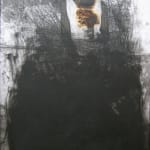

J. Roberto Diago Cuban, 1971
152.4 x 101.6 cm
Unique
Juan Roberto Diago’s Untitled, from the series Rostro que solo yo veo (2003), is a striking body of work created for the Havana Biennial, where the artist used black-and-white photographs to capture individuals living in extreme poverty. However, these are not mere documentary images; Diago intervened in each piece—erasing, crossing out, and even burning the faces of the subjects.
This violent manipulation transforms the photographs into raw, textured surfaces that almost resemble metal, as if the very material has been scarred and corroded. The act of obliterating faces speaks to historical erasure—the way marginalized communities, particularly Afro-Cubans, have been overlooked, silenced, or made invisible within official narratives. The burned-out features become haunting voids, emphasizing the dehumanization that results from systemic neglect and racism.
Yet, rather than simply depicting suffering, Diago’s intervention forces the viewer to confront the absence. Who are these people? What stories remain untold? By defacing their images, the artist paradoxically restores their presence—forcing us to acknowledge those who exist in the margins, yet whose identities have been obscured by history.
The series, created for the Biennial, also speaks to Cuba’s broader social struggles, particularly in the post-Soviet Período Especial when economic hardship deepened racial disparities. The aesthetic of destruction—burning, scratching, erasing—mirrors both personal and collective trauma, making each photograph not just a representation, but a physical manifestation of pain, resilience, and the urgency of visibility.


